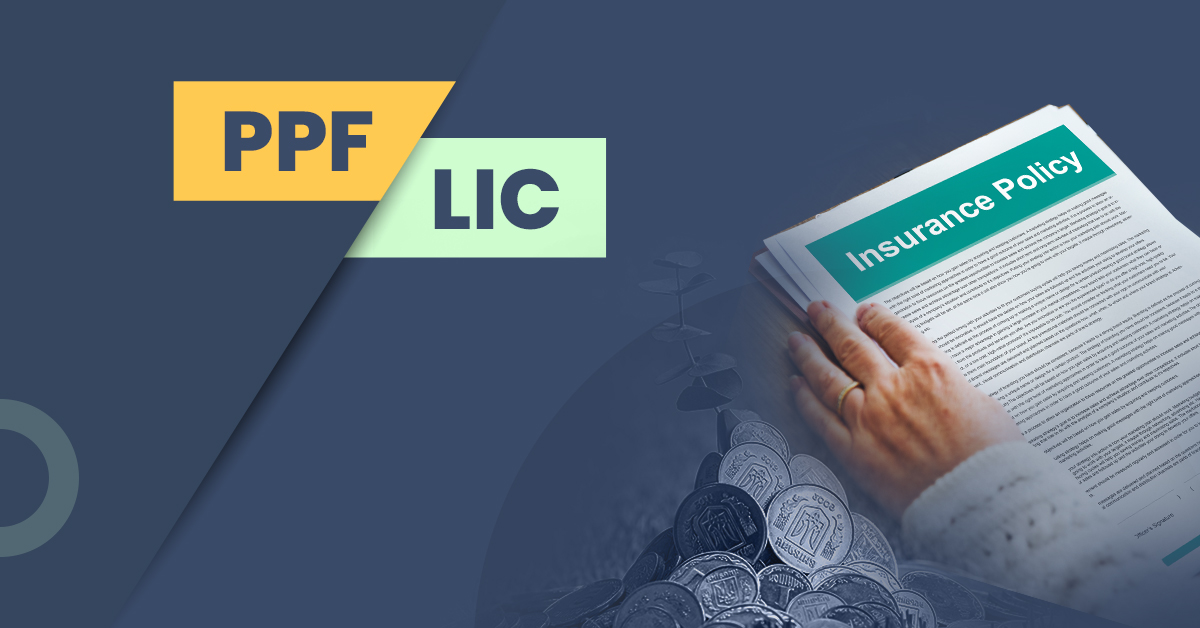PPF vs LIC: A Detailed Comparison


When it comes to investment avenues, there are different options available in the market. You can choose from fixed-income instruments or market-linked securities. Moreover, depending on your investment horizon, you can invest in long-term and short-term avenues.
PPF and LIC policies are two famous investment avenues.PPF is a long-term saving scheme that helps accumulate a guaranteed corpus with fixed returns. On the other hand, LIC helps plan for emergencies and gives financial security. Both PPF and LIC plans have their respective features, benefits and limitations.
You can invest in one or both of these avenues depending on your financial needs and goals. However, before investing, you should understand these avenues, their similarities, and their differences. So, let’s explore PPF vs LIC policies.
What is a LIC Policy?
LIC stands for Life Insurance Corporation of India. It is a state-owned life insurance company that offers different insurance policies. Most of these policies cover the risk of premature death.
In a LIC policy, you have to pay regular premiums or one single premium to receive a lump-sum payment upon maturity of the policy. However, if a policyholder unfortunately passes away within the policy’s tenure, the nominee will receive the insured amount. Thus, LIC acts as a risk cover for the policy holder’s family.
What is PPF?
PPF stands for Public Provident Fund. It is a long-term government-backed savings scheme that has a tenure of 15 years and offers a fixed interest rate. You also get the option to extend the investment duration in blocks of five years.
The PPF account gives you tax benefits since your investments and returns are tax-free as well. That is why the PPF scheme is favoured by many to create a secured corpus for their long-term financial goals.
Differences Between LIC vs PPF Policies
Some of the significant differences between PPF and LIC Policies are listed below:
| Parameters | Public Provident Fund | Life insurance policies issued by LIC |
| Tenure | It is a long-term saving scheme that runs up to 15 years and can be extended further in blocks of 5 years. | Life insurance policies are available for terms starting from 5 years and going up to your lifetime. |
| Returns | The rate of interest is guaranteed. It is determined and reviewed by the Government. Currently, it stands at 7.1% | The interest rate depends on the type of policy you choose. Moreover, if you invest in unit-linked insurance plans, the returns would depend on the market performance and are hence not guaranteed. |
| Deposits Frequency | You have to contribute to the PPF account every year. | You can pay the life insurance premium in a lump sum or in regular intervals throughout the policy term. |
| Investment Goal | PPF helps you save and create a corpus for different financial goals. | Life insurance plans help compensate for the financial loss from premature death.Moreover, you can also plan your financial goals with the various schemes available. |
| Partial Withdrawals | Partial withdrawals are allowed from the 7th year | A life insurance policy can be surrendered before the chosen term. However, the benefits reduce significantly in such cases. |
| Regulators | The Government of India regulates the scheme. | Life insurance is regulated by the Insurance Regulatory and Development Authority of India (IRDAI). |
| Deposit Amount | The minimum investment required is Rs.500, and the maximum is limited to Rs.1.5 lakhs. | The minimum premium depends on the insurance policy that you buy. Moreover, most plans do not have a maximum limit on the premium. You can invest as much as you want. |
| Premature Death | In the case of the account holder’s death, the PPF account can be closed prematurely, with the nominee getting the available balance. | In the case of death, a death benefit is paid under life insurance policies. This benefit can be more than the premiums paid by the policyholder during their lifetime. |
| Opening Facility | You can open a PPF account with a bank or a post office. | You can buy a life insurance policy from LIC through their agents or following a simple online process. |
PPF vs LIC: Similarities
While PPF and LIC are quite different as investment avenues, they share some similarities too. These are discussed below:
- Partial withdrawals
Under the PPF account, you can make partial withdrawals from the account balance up to specified limits. These withdrawals do not affect the continuity of your investments and can be done from the seventh year of opening the account.
Under unit-linked life insurance plans offered by LIC, partial withdrawals are available after the completion of five years. - Loan facility
You can get a loan against your PPF account from the third year until the end of the seventh year. Traditional life insurance plans, like endowment policies, also offer loans after the lock-in period of three years is complete. - Revival
If you miss contributing to the PPF account in any financial year, you can revive the account in the next year. In life insurance plans, if you miss the premium payment, you get a revival period during which you can restore the coverage. - Tax benefit on investment
The amount you invest in the PPF or life insurance scheme is allowed as a deduction under Section 80C. The maximum limit of deduction is Rs.1.5 lakhs. For life insurance policies, deduction is restricted to 20% of capital sum assured in respect of policies issued on or before 31-3-2012 and 10% in case of policies issued on or after 1-4-2012. In case of policy taken on or after 1-4-2013 in the name of any person suffering from disability or severe disability referred to in section 80U or suffering from disease or ailment as given in section 80DDB, the limit will be 15% of capital sum assured.
- Tax benefit on returns
The returns earned and the maturity benefit received from the PPF account is entirely tax-free in your hands.
In the case of life insurance policies, too, the death benefit is altogether tax-free in your nominee’s hands. Even in the case of maturity benefits, if the premium was less than 10% of the sum assured, for policies issued after 1 April 2012, and 20% for policies before 1 April 2012, the amount you receive would be entirely tax-free under Section 10(10D) of the Income Tax Act, 1961.
Final Thoughts
Both PPF accounts and life insurance policies have their own set of benefits. Thus, it would help if you understood what these avenues are all about before investing in them. Don’t compare PPF vs LIC to determine the best one because they are very different. Instead, assess your financial needs and then make a choice. You can choose both PPF and life insurance policies to enjoy the benefits that they provide. While the PPF scheme would help you create a long-term, tax-efficient corpus, the life insurance policy would give financial security. So, as you plan for your goals, you can secure your planning with life insurance.
So, rather than LIC vs PPF, invest in both and maximise tax savings.
FAQs
LIC or PPF, which is better?
Both LIC and PPF have their respective pros and cons. As such, choosing which is better is difficult. That being said, you can select LIC if:
You want insurance coverage.
You need to save for a specific financial goal, like retirement.
You want to invest more than Rs.1.5 lakhs.
You want to invest in unit-linked plans.
On the other hand, PPF is better if:
You want guaranteed returns.
You want to save affordably.
You want to invest for a long time.
You don’t need insurance coverage.
So, assess your financial needs, goals, investment horizon and strategy and choose the most suitable option. You can also select both options for maximum benefits.
Which LIC policy is the best?
The choice of the best policy depends on your needs. Here’s how:
If you want to secure your family’s finances in your absence, a term plan would be the best.
A child plan will be the best if you want to create a secured corpus for your child’s future.
If you want insurance and investment returns, ULIPs would be better.
If you want to save for retirement, pension plans would be good.
So, assess your needs and determine which policy best fulfils such needs.
What are the other fixed-income saving avenues besides PPF?
Besides PPF, you can invest in fixed deposits, recurring deposits, National Saving Certificates, Kisan Vikas Patra, post-office term deposits, etc., for fixed returns.
Which LIC policy gives the highest returns?
Different LIC plans offer separate returns. For guaranteed returns, you can invest in an endowment or money-back plan.
Do I get inflation-adjusted returns from PPF?
The PPF scheme offers a fixed rate of return. This return does not consider the inflation factor. As such, inflation might exceed the returns of the scheme, giving no actual returns on your savings. So, with PPF, you don’t get inflation-adjusted returns.







